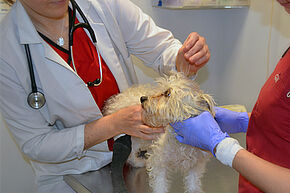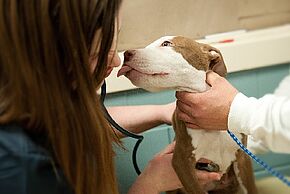An Ideal State for Animals
Chicago has seen tremendous progress, with killing reduced by more than 91% since PAWS Chicago’s founding in 1997. But Chicago is still not a No Kill community. We have more work to do for animals.
To reach our mission of No Kill, there are important and distinct roles for private shelters and government (also called municipal) shelters.
How a Model No Kill Community Works
In a model No Kill city, all healthy and treatable animals are saved. Euthanasia is reserved only for dogs or cats who are hopelessly sick or injured and suffering, where medical treatment cannot alleviate the condition, or for dogs who are deemed dangerous and non-rehabilitatable by behavior experts who believe that they pose a real threat to public safety.
The No Kill Model is fully implemented, including:
- A robust foundation of community engagement in the cause of homeless animals
- Prevention efforts including free and low-cost spay/neuter surgeries, trap-neuter-return and community outreach to reduce the number of homeless pets at the source
- Extensive and high profile network of adoption opportunities for people looking for pets
- Treatment and rehabilitation for animal health and behavior, including shelter medicine and behavior enrichment and modification to save all treatable pets
- Volunteer support in every aspect of a shelter’s operations is the only way to provide high quality standard of care for homeless animals.
Private Shelters in a No Kill Community
Private No Kill shelters are privately funded by donors in the community; they do not take government funds. In a No Kill community, these animal welfare organizations offer robust programs and services aligned with the No Kill Model, including prevention, adoption, animal health and behavior, volunteers and community engagement.
In a model No Kill community, all private shelters manage their admissions much like human services do, taking in only as many pets as they can care for with all of their donor dollars going to saving lives, not ending lives. This managed admissions approach works with each case individually to ensure his needs are met.
Every institution has capacity and resource constraints. If a hospital or domestic violence shelter has only 1,000 beds, they will not take in 2,000 people and kill the excess. Much like their human counterparts, a No Kill shelter triages pets to take in crisis care and emergency cases first.
When a family gives up their pet, the shelter informs them of the reality of pet homelessness and offers educational counseling and alternatives. During the busiest times, these private shelters will ask people with less critical needs to keep their pet a few weeks or utilize a network of foster homes to take in pets while the shelter is operating at capacity.
Once pets are in the adoption program, the life of each animal is prioritized. Private donor dollars go to treating and saving the lives of all healthy and treatable animals that come through the shelter’s doors. Experts in shelter medicine and animal behavior work to treat and rehabilitate all sick, injured and behaviorally challenged pets.
Traditional, open door shelters would no longer exist, since they are utilizing an outdated “cage and kill” operating model that replicates government services.
The Government’s Role in a No Kill Community
In a model community, Animal Care & Control (ACC), or the city pound, is primarily responsible for keeping homeless pets off the streets. ACC would serve as the central location for stray and unwanted pets. For cases of animal cruelty, they would work in conjunction with the city’s law enforcement.
As the community’s open door shelter funded by tax dollars, ACC would take in all animals and give them a quality standard of care, including treatment, rehabilitation and enrichment during their stay. This means that a comprehensive shelter medicine program, including an experienced veterinary team, isolation, cleaning and care protocols and medical grade facilities with isolation and treatment wards designed to reduce disease transmission. Qualified animal behavior experts on staff would evaluate temperament of all pets to prevent deterioration, improve socialization and support transfer and adoption efforts.
Volunteers would support every aspect of the city’s program to enable a high standard of care for each pet.
A centralized and easily accessible database is readily available for citizens to search for lost pets.
Private shelters would support the city shelter by transferring pets into their adoption programs. With an active transfer culture, there is a safety net for the pets who enter the city shelter.
Most important of all, the government promotes full transparency about the state of animal welfare in the community. When the city agency is the only open door shelter in a community, euthanasia would be exposed with greater transparency and freedom of information required by law. Additionally, the city is uniquely positioned to use its robust communications networks to engage the community at large and other city services in a culture of life-saving.
In an optimal community, the city would also provide prevention services, including free and low-cost spay/neuter, Trap-Neuter-Return and outreach initiatives, but, at a minimum, the city would work with private organizations providing these services to ensure all citizens are informed of available services.
With the community engaged and with private animal welfare organizations and government impoundment facilities working together to implement the No Kill model, No Kill communities are within reach.




